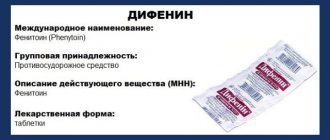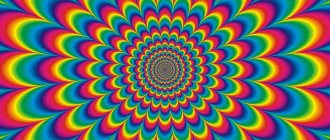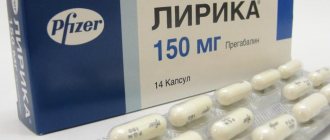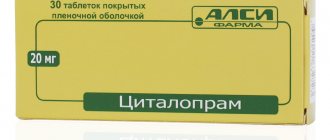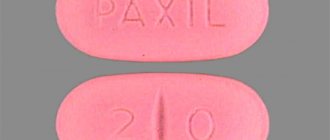The compatibility of Anafranil and alcohol provokes side effects that can lead to coma and death.
The drug, in addition to its therapeutic effect, saturates the body with harmful substances, so the toxic effects of ethanol can aggravate the situation.
Alpha Normix and alcohol
Mydocalm and alcohol
Cefazolin and alcohol
Metadoxyl and alcohol
Use search
Are you having any problem? Need more information? Type in the form and press Enter!
Release form and composition
The drug is released in this form:
- Anafranil 25 mg, tablets No. 10, 30. Light yellow, biconvex, round.
- Anafranil 75 mg, tablets. Pink, capsule-shaped, biconvex, with an engraved stripe on both sides, “C/G” on one side, “G/D” on the other. Sold in blisters, in a cardboard box. Each blister contains 10 pieces.
- Solution for IM or IV administration 25 mg, ampoules. Colorless, transparent. Sold in cardboard packs of 10 pieces.
Dosage regimen
Doses are directly dependent on the patient’s condition and the specific indications for the drug. In severe cases, Anafranil is prescribed in the form of intramuscular or intravenous injections with a gradual transition to oral administration. The dosage of the drug is always increased gradually, starting from the minimum therapeutic dose and ending with the average therapeutic dose.
For depressive syndrome, start with 75 mg once or 25 mg three times a day. In case of mild disease, you can leave this dosage, moderate - increase to 150, severe - use 200-250 mg per day.
Pharmacological effect
The active component of Anafranil is clomipramine, an antidepressant with a pronounced sedative and moderate analgesic effect. According to some reviews, Anafranil is distinguished by its ability to relieve depression, anxiety, and have a disinhibiting effect.
The drug helps with eating disorders such as bulimia, which may be accompanied by depression. Manifestations of a depressed state of the nervous system begin to subside a week after the start of treatment. It is undesirable to prescribe Anafranil to patients with narcoleptic drowsiness: in this case, the medicine is ineffective.
Indications for use
The use of Anafranil in adults is required for:
- Chronic pain syndromes;
- Phobias and panic attacks;
- Depressive states of various origins;
- Obsessive-compulsive syndromes;
- Dissociative disorders;
- Cataplexy accompanying narcolepsy.
Anafranil is indicated for children and adolescents for:
- Obsessive-compulsive syndromes;
- Nocturnal enuresis.
Treatment of nocturnal enuresis is carried out only in children over 5 years of age. Organic causes of the disease must first be excluded and the relationship between potential benefit and risk for the child must be established.
Currently, the safety and effectiveness of Anafranil in children and adolescents in the treatment of depressive conditions, phobias, panic attacks and chronic pain syndrome have not been sufficiently studied. Therefore, for such indications, the drug is not recommended for use in patients under 17 years of age.
Contraindications
The drug is not prescribed:
- pregnant and lactating women;
- when taking MAO inhibitors (two weeks before and after), reversible MAO-A inhibitors;
- if you are allergic to tricyclic antidepressants, dibenzazepine or clomipramine groups;
- if you have recently had a myocardial infarction;
- children under 5 years old;
- with long QT interval syndrome.
Please be careful:
- persons with cardiovascular insufficiency or arrhythmia;
- with glaucoma or urinary retention;
- people who have a tendency to experience constipation, especially for bedridden or elderly people;
- with serious liver disease or hyperthyroidism;
- To old people;
- teenagers;
- for brain injuries;
- for epilepsy;
- when combining the drug with antipsychotics;
- with a tumor of the adrenal medulla;
- with neuroblastoma or pheochromocytoma.
When using the medicine, you should constantly monitor your blood pressure and monitor your intraocular pressure.
If the patient uses contact lenses, it must be remembered that the drug can reduce the intensity of tear production. This may damage the cornea.
Particular care should be taken when administering the drug intravenously to avoid anaphylactic shock.
Compatibility of Anafranil and alcohol
Combining substances is prohibited. The antidepressant is taken only after the body has completely cleansed itself of the breakdown products of ethyl alcohol.
Substances have different effects. When a person gets drunk, he makes himself even more depressed. The drug was created to improve psychological well-being. Therefore, the combination is dangerous; there have been cases of death. It is impossible to say exactly what the reaction will be.
It depends on factors:
- dosage;
- physical state.
There may be a temporary improvement in mood, after which there is a high risk of coma or paralysis. After simultaneous use, it is best to consult a doctor. Timely measures taken will prevent serious consequences for the body.
Some alcoholic drinks contain tyramine. This is a dangerous substance, an analogue of adrenaline. If you drink wine with medicine, a sharp jump in blood pressure is possible.
The result is a heart attack or stroke. What is the danger: even if you stop therapy immediately, the risk of getting sick remains for 14 days.
Take the Attention Test! Find 10 differences! (click right here!)
Use during pregnancy and lactation
Experience with the use of Anafranil during pregnancy is limited. Since there are isolated reports of a possible connection between the use of tricyclic antidepressants and fetal developmental disorders, the use of Anafranil during pregnancy should be avoided, unless the expected effect of treatment on the mother clearly outweighs the potential risk to the fetus.
In cases where tricyclic antidepressants were used during pregnancy until delivery, the neonate developed a withdrawal syndrome within the first few hours or days, manifested by shortness of breath, drowsiness, colic, irritability, hypotension or hypertension, tremor, cramping, or convulsions. To avoid the development of this syndrome, Anafranil should be gradually withdrawn, if possible, at least 7 weeks before the expected birth.
Since the active substance of the drug is excreted in breast milk, you should either stop breastfeeding or gradually discontinue Anafranil.
Anafranil and beer
Taking Anafranil and beer together is prohibited, because a tandem with antidepressants can be fatal. Sudden changes in blood pressure can lead to a stroke or heart attack.
Possible complications of a tandem of two substances:
- hallucinogenic visions;
- sexual problems;
- severe depression;
- unstable pulse;
- disorientation in space;
- poor concentration;
- lethargy;
- pain in the kidneys and liver;
- intoxication of the whole body.
A sharp surge of strength and vigor is the first sign of impending intoxication. After it, the person is overcome by severe depression, anxiety and panic.
Instructions for use Anafranil
The instructions for use indicate that Anafranil tablets are taken with or after food. This will prevent irritation of the mucous membrane. The solution is administered intravenously or intramuscularly. Therapy is carried out in minimally effective dosages.
| Condition, indication | Release form, dosage | Dosage regimen (once daily), first week of therapy and maintenance therapy | Therapy from the second week until the effect is achieved |
| Depressions of various origins | — tablet Anafranil 25 — tablet Anafranil SR | 2-3 times 1 time (in the evening) | 4 times/day 2 times/day |
| Phobias | — tablet Anafranil 25 — tablet Anafranil SR | 2-3 times 1 time | 4 times/day 2 times/day |
| Obsessive-compulsive syndromes | — Anafranil 25 tablet — Anafranil CP tablet | 2-3 times 1 time (in the evening) | 4 times/day 2 times/day |
| Narcolepsy with catalepsy | — Anafranil 25 mg/2ml | 1-3 ampoules/day | 1-3 ampoules/day |
| Chronic pain syndrome | — tablet Anafranil 25 — tablet Anafranil CP — Anafranil 25 mg/2ml | 0.5-6 tab. /day 1-2 tablets/day 0.5-6 ampoules/day | 0.5-6 tablets/day 1-2 tablets/day 0.5-6 ampoules/day |
| Attacks of fear | — tablet Anafranil 25 | 0.5 tablets/day | 0.5 tablets/day or increase to another minimum effective dosage |
| Indications for the elderly | — tablet Anafranil 25 | 0.5 tablets/day | 1-2 tablets/day |
| When indicated in children 5-7 years old | — tablet Anafranil 25 | Up to 1 tablet/day | Up to 1 tablet/day |
| When indicated in children 8-14 years old | — tablet Anafranil 25 | 0.5-2 tablets/day | 0.5-2 tablets/day |
In elderly patients, the initial dose is 10 mg/day. Then gradually, over about 10 days, the daily dose of the drug is increased to the optimal level, which is 30-50 mg.
Side effects
The use of Anafranil may cause the following side effects:
- Hematopoietic system: agranulocytosis, leukopenia, thrombocytopenia, eosinophilia, purpura;
- Hypersensitivity reactions: systemic anaphylactoid reactions, allergic alveolitis with or without eosinophilia;
- Sense organs: tinnitus, disturbance of taste;
- Cardiovascular system: palpitations, sinus tachycardia, orthostatic hypotension, increased blood pressure, arrhythmias, minor changes in the ECG, intracardiac conduction disorders;
- Digestive system: nausea, vomiting, diarrhea, abdominal discomfort, anorexia, hepatitis, increased levels of liver enzymes;
- Skin reactions: skin allergies (photosensitivity, urticaria, rash, itching), swelling, alopecia;
- Endocrine system: impaired potency and libido, weight gain, swelling of the mammary glands, galactorrhea, syndrome of inadequate response of antidiuretic hormone;
- Central and peripheral nervous systems: feeling of fatigue, drowsiness, increased appetite, anxiety, disorientation, confusion, hallucinations, agitation, anxiety, depersonalization, manic state, tremor, headache, delirium, paresthesia, increased muscle tone, ataxia, convulsions.
Overdose
Manifestations of an overdose of Anafranil gain momentum 4 hours after excessive use. These include:
- drowsiness, insomnia, confusion, anxiety;
- muscle rigidity, ataxia, stupor;
- seizures of an epileptic nature;
- failures of intracardiac conduction, rapid rhythm.
Signs of poisoning last for four to six days. According to a number of reviews about Anafranil, a large dosage can cause vomiting, lack of urine formation, and severe sweating. Sometimes there is dilation of the pupils, shortness of breath, and depression of the respiratory process.
Therapy for an overdose of Anafranil is performed in several ways:
- if Anafranil was taken in tablets, then the patient should rinse the stomach, then prescribe activated charcoal;
- in case of severe poisoning with Anafranil: artificial ventilation, cholinesterase inhibitors, anticonvulsant measures. Methods such as diuresis and hemodialysis have been found to be ineffective.
special instructions
- Caution should be exercised if the patient is predisposed to constipation.
- Taking antidepressants increases the likelihood of suicidal thoughts and suicide attempts. Family members and those around the patient (guardians) should remember this. Also, if such tendencies have not previously been observed in the patient, then the drug should be discontinued.
- During treatment, the level of leukocytes may change; therefore, blood counts need to be monitored.
- In persons predisposed to psychosis and the elderly, the drug can cause nocturnal delirious psychosis. After stopping taking the drug, these side effects go away.
- Patients with panic attacks may experience a deterioration in their condition in the first days of treatment; as a rule, they feel better after a week.
- The drug should be combined with electroconvulsive therapy only if the patient’s well-being is carefully monitored.
When writing a prescription, you should indicate the minimum number of tablets required at the moment, in order to avoid accidental overdose of the drug.
Consequences of drinking alcohol
Ethyl alcohol and the drug are incompatible. Complications affect many body systems, primarily affecting the central nervous system.
List of consequences:
- hallucinations;
- sexual disorders;
- deep depression (ethanol stops the drug from working);
- increased heart rate;
- the drug turns into a toxic substance that can cause stroke or death;
- increased side effects;
- disturbance of thought processes;
- poor concentration;
- memory problems, inability to remember large amounts of information;
- strong hypnotic effect, a person will not be able to do anything at all;
- slower reaction;
- kidney dysfunction;
- intoxication of the body;
- development of alcoholism (the combination speeds up the process several times).
It happens that simultaneous use gives a surge of strength. It is important to understand that this is a short-term phenomenon. This will be followed by a deterioration in the psychological state. The person will feel very depressed. This condition is dangerous because it can lead to suicide attempts.
If you want to drink during treatment, you need to tell your doctor about it. He will tell you what to do correctly so that serious consequences do not arise.
Drug interactions
You need to remember that:
- If it is necessary to prescribe Fluoxetine, at least 2-3 weeks should pass between taking this drug and Anafranil.
- It is advisable not to take diuretics during the course.
- Anafranil can enhance the effect of anticholinergics on the central nervous system, eyes, bladder, intestines (atropine, biperidine, antihistamines, antiparkinsonian drugs).
- Do not co-administer or immediately after discontinuation of MAO inhibitor drugs.
- Anafranil inhibits the action of batanidine, guanethidine, resirpine, alphamethyldopa, clonidine.
- Before anesthesia, you should warn the specialist about treatment with the drug.
- Do not take with drugs that prolong the QT interval.
- Do not use with other drugs that inhibit the action of Anafranil (recapture serotonin and norepinephrine).
- The drug can enhance the effect of sympathomimetic drugs on the cardiovascular system (adrenaline, norepinephrine, ephedrine, phenylerine).
The drug may enhance the effects of alcohol and other central nervous system depressants.
Action of antidepressants
The patient will not immediately notice the effect of taking antidepressants. This will happen approximately 2 weeks after starting to take the pills. A sufficient amount of the active compound must accumulate in the human body, then he will feel the benefits. You should not immediately stop taking antidepressants; the therapeutic effect will certainly appear only later.
Tranquilizers, as well as antipsychotics, can act faster than antidepressants. The latter are taken in courses. The withdrawal of drugs should be gentle, gradual, so that the body adapts to function without the drug, and the gone depression does not return again.
Antidepressants are easy to buy at the pharmacy, where they are available in abundance. The effect of these medications is due to changes in the content of neurotransmitters in the brain tissue. The lack of these substances affects a person’s mood, causing feelings of depression, sadness, anxiety, and hopelessness. Antidepressants can increase the amount of neurotransmitters in the brain or increase the sensitivity of neurons to them.
SSRIs (Selective Serotonin Reuptake Inhibitors) can lift a person’s mood and relieve him of postpartum depression, bulimia, the consequences of alcohol abuse, and severe feelings of anxiety. This class of drugs works by increasing the brain's use of serotonin. This chemical is responsible for transmitting impulses between cells. It is advisable to take medications for about 6 weeks. The result of their use is noticeable already in 3 weeks.
People's reviews about the drug Anafranil
We have made a selection of reviews in which people tell how they felt after taking Anafranil:
- Hi all! I don’t know if my experience will be useful, but I’ll share. I have been taking this drug my whole life - 25 years. 14 for the night. It wasn't bad. But the orgasm disappeared completely, that was the problem. Although depression is an even bigger problem. After 10 years I gave it up, there was no withdrawal syndrome, but after 1 year 3 months I abruptly stopped walking, moved around holding onto the walls, my head was a mess instead of brains, it was unclear where the floor was, where the ceiling was, my facial features were greatly distorted. He was urgently appointed again. And everything passed immediately. So, apparently, the drug is not just bad - it’s terrible. Now I'm sweating so much that I can't leave the house. Thankfully I'm retired. Almost all the side effects are mine, and these are entire diseases. No life. And I’m afraid to leave him again - I don’t want a repetition of the situation when you stop being a normal living being altogether. I don't know what to do...
- He pulled me halfway from the other world and these are not empty words. At the age of 30, fate gave me a gift in the form of OCD. Over the course of 6 months, OCD drove me into severe depression with all the severe consequences (insomnia - I couldn’t close my eyes for about 8 days and this is not an exaggeration, I realized that this was possible, then against this background I had thoughts of suicide). In general, I gave up and went to a good doctor who prescribed me Truxal and Anafranil, after 1.5 months my sleep was restored and I’ve been taking Anafranil for 6 months now... I completely forgot about the side effects of the drug in the first month of taking it, in general, be patient and you will be happy!
Reviews about Anafranil on the forums are good. The product helps cope with obsessive thoughts and ideas, depression , and returns the will to life to patients. However, the drug has a lot of side effects and only a doctor has the right to prescribe it.
When can you drink alcohol if you are taking or have taken the drug?
How long before you can drink alcohol is a question that often arises. Despite the fact that the drug is quickly eliminated from the body, the minimum period of abstinence is 72 hours. It is best to wait 7 days. This is a guarantee that the therapeutic effect will last for a long time.
If the rules have been broken and consequences arise, it is important to quickly seek medical help.
Depression is a condition that requires treatment. It fights apathy only if taken correctly. The most important thing is a complete abstinence from alcohol-containing drinks.
Storage conditions and shelf life
Store out of the reach of children at a temperature not exceeding 30 °C. Shelf life: 5 years.
How do you feel after Anafranil: instructions for use and reviews - tips and recommendations on News4Health.ru
Life in the modern world is replete with many factors that negatively affect human health. The main ones are poor ecology, questionable quality of food, contaminated drinking water, poor quality medical care, as well as stressful situations and bad habits. Therefore, it is so important to pay attention to regular healing of the body using various methods and means. Be sure to consult a specialist so as not to harm your health!
Antidepressants and alcohol
The effects of antidepressants and alcohol on the human body can be called opposite. Alcohol aggravates depression, and medications relieve it. Treatment with drugs is long-term, sometimes the doctor considers it necessary to adjust it. During the entire period of taking pills or injections (in severe cases), a person may have a desire to drink alcohol. There are many holidays throughout the year and plenty of occasions for a particular family to drink. But taking drugs containing ethanol and antidepressants together is dangerous. It can cause significant harm to health. The effect is usually unpredictable. The patient may feel unwell, possibly even die. Taking multicomponent medications or combination drugs is especially dangerous.
A reaction from a mixture of pills and alcohol can cause a striking multifactorial process. What exactly the effect will be depends on many reasons and on the strength of the body of a particular person and on the dosage. Therefore, the consequences cannot be predicted. They are always different. The patient may experience a surge of strength, an increase in mood, or he may be paralyzed, a coma will follow, and urgent hospitalization will be required to avoid death.
Alcohol and antidepressants have psychoactive effects. The first inhibits regulatory centers in the body and suppresses natural processes. The latter are necessary to normalize human functions. Medicines act through monoamines. These bioactive substances regulate a person’s mood, activity, and vigor. Important monoamines include norepinephrine, histamine, adrenaline, serotonin, dopamine, and melatonin.
Ethyl alcohol can cause monoamine deficiency because ethanol increases the release and also increases the consumption of important substances in the body. Alcohol worsens depression, spoils mood, euphoria is fleeting and only makes you forget about problems for a moment. At the physiological level, there are processes that force the body to work for wear, and in this case the mood cannot rise.
Thanks to antidepressants, a person’s emotional background is leveled out. Humoral as well as nervous reserves accumulate. Due to alcohol consumption, the body “acts in disarray.” Therefore, antidepressants should not be combined with ethanol. Combination with monoamine oxidase inhibitors is especially undesirable. The enzyme (monoamine oxidase) is responsible for important processes, namely the destruction of monoamines. Thanks to antidepressants, hormones remain longer, circulate in the blood, and a person’s mood improves.
Some alcoholic drinks contain tyramine. Its structure is similar to adrenaline. If a patient drinks beer or wine where this substance is present, and at the same time he is being treated with antidepressants, then the pressure can jump to a critical level. Hypertensive crisis is possible. Even if you stop taking antidepressants, the risk of such illnesses will continue for another 2 weeks.
Factors influencing the body's reaction when combining alcohol and antidepressants:
- type of alcoholic beverages;
- ambient temperature;
- food consumed;
- a type of antidepressant;
- biochemistry of a particular organism;
- dose of alcohol.
A person will get the maximum benefit from taking antidepressants if they do not interrupt treatment. Otherwise, a long period of drug treatment may be useless. Consumption of alcohol-containing substances interferes with and disrupts the healing process. To improve the effectiveness of therapy, doctors have to adjust or cancel prescribed medications for about 2 weeks. Such a break is fraught with an increase in depressive states, headaches, and you will also have to restore the liver and kidneys.




